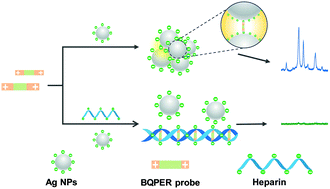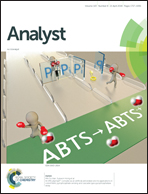In situ formation of SERS hot spots by a bis-quaternized perylene dye: a simple strategy for highly sensitive detection of heparin over a wide concentration range†
Abstract
A simple and ultrasensitive surface-enhanced Raman scattering (SERS) assay for heparin detection has been demonstrated based on an in situ hot spot assembly method using N,N′-bis[3,3′-(trimethylammonium)propylamine]-3,4,9,10-perylenediimide (bis-quaternized perylene dye, abbreviated as BQPER). In this assay, a BQPER probe with two positive charges is employed as both Raman reporter and electrostatic bridge to cause the aggregation of citrate-capped Ag nanoparticles (Ag NPs), resulting in a strong SERS signal due to the formation of numerous hot spots in the gaps of the aggregates. The SERS intensity of BQPER decreases in the presence of heparin, because BQPER binds primarily to heparin due to its high anionic charge to mass ratio compared to that of Ag NPs. Accordingly, a novel method for the detection of heparin has been developed based on SERS of the unbound BQPER probe. Two obvious advantages of the proposed heparin assay over other reported methods are: its much wider linear concentration range (10−5–10−10 g mL−1) and lower limit of detection (0.08 ng mL−1). Besides, our proposed heparin assay has been successfully applied to the detection of heparin in serum samples, indicating its great potential in the diagnosis of heparin-related diseases. This work provides a new Raman probe for the SERS analysis of heparin and opens a different perspective for SERS-based transducer design in charged analytes.



 Please wait while we load your content...
Please wait while we load your content...